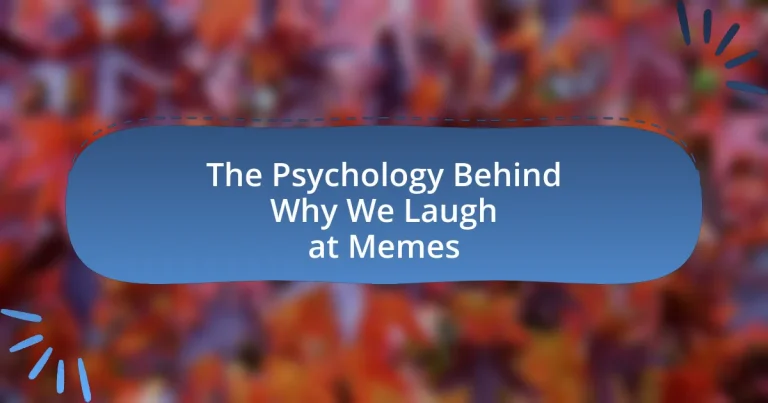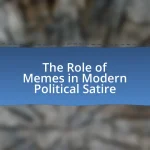The article explores the psychology behind why we laugh at memes, focusing on the concepts of incongruity and social connection. It examines how memes trigger laughter by activating the brain’s reward system and discusses the neurological processes involved in this response. The article also highlights the variability in humor perception among individuals based on cultural context and personal experiences, as well as the factors that make certain memes more relatable and impactful. Additionally, it addresses the role of memes in reflecting societal norms, shaping public perception, and fostering community through shared humor, ultimately linking laughter at memes to positive mental health outcomes.
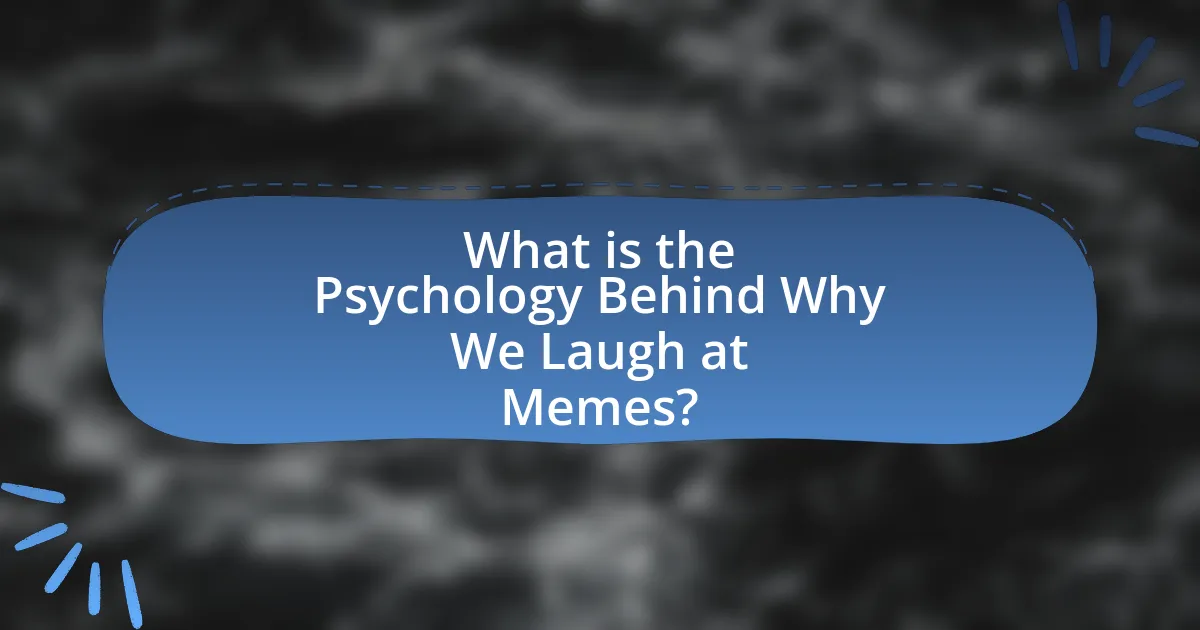
What is the Psychology Behind Why We Laugh at Memes?
The psychology behind why we laugh at memes is rooted in the concepts of incongruity and social connection. Memes often present unexpected or absurd scenarios that challenge our expectations, triggering laughter as a cognitive response to the surprise. This aligns with the incongruity theory of humor, which posits that humor arises when there is a discrepancy between what we anticipate and what actually occurs. Additionally, memes serve as a form of social commentary, allowing individuals to connect with others through shared experiences and cultural references, reinforcing group identity and social bonds. Research indicates that laughter can enhance social cohesion, as seen in studies showing that shared humor fosters relationships and group dynamics.
How do memes trigger laughter in our brains?
Memes trigger laughter in our brains by activating the brain’s reward system, particularly the release of dopamine, which is associated with pleasure and humor. When individuals encounter a meme that resonates with their experiences or contains an unexpected twist, their brains process the incongruity, leading to a cognitive shift that elicits laughter. Research indicates that humor is often derived from the violation of expectations, and memes frequently employ this technique through visual and textual elements that surprise or amuse the viewer. For instance, a study published in the journal “Cognitive Science” by authors such as Sophie Scott highlights how humor activates specific neural pathways, reinforcing the connection between memes and laughter.
What neurological processes are involved in laughter when viewing memes?
Laughter when viewing memes involves several neurological processes, primarily engaging the brain’s reward system, including the ventral striatum and the prefrontal cortex. The ventral striatum is activated during pleasurable experiences, releasing dopamine, which reinforces the enjoyment of humor. Additionally, the prefrontal cortex plays a role in cognitive processing and social understanding, allowing individuals to interpret the humor in memes. Research indicates that humor activates the anterior cingulate cortex, which is involved in emotional regulation and response to incongruity, a common element in memes. These processes collectively contribute to the experience of laughter as a social and emotional response to humor.
How does humor perception differ among individuals when it comes to memes?
Humor perception varies significantly among individuals when it comes to memes due to factors such as cultural background, personal experiences, and cognitive styles. Research indicates that cultural context influences what individuals find humorous; for instance, memes that reference specific cultural events or norms may resonate more with those familiar with them, while others may not understand the humor. Additionally, personal experiences shape humor appreciation; individuals who have encountered similar situations may find related memes funnier. Cognitive styles also play a role; people with different thinking patterns may interpret the same meme in diverse ways, leading to varying levels of amusement. Studies, such as those published in the journal “Humor: International Journal of Humor Research,” highlight these differences, demonstrating that humor is subjective and influenced by a multitude of individual factors.
Why do certain memes resonate more than others?
Certain memes resonate more than others due to their relatability, emotional impact, and cultural relevance. Memes that tap into shared experiences or emotions create a sense of connection among viewers, making them more likely to be shared and appreciated. For instance, research by the University of California, Berkeley, indicates that humor often arises from incongruity and the violation of expectations, which can enhance the appeal of a meme. Additionally, memes that reflect current events or popular culture tend to gain traction because they align with the collective consciousness of society, as evidenced by the rapid spread of memes during significant social movements or viral trends.
What role does relatability play in the humor of memes?
Relatability is a crucial factor in the humor of memes, as it allows individuals to connect their personal experiences with the content presented. When memes depict situations, emotions, or thoughts that resonate with a wide audience, they evoke laughter through shared understanding. Research indicates that humor often arises from recognizing one’s own life in the scenarios portrayed, making the experience more enjoyable and engaging. For example, a study published in the journal “Computers in Human Behavior” found that memes that reflect common social experiences are more likely to be shared and appreciated, highlighting the importance of relatability in enhancing comedic impact.
How does cultural context influence the effectiveness of meme humor?
Cultural context significantly influences the effectiveness of meme humor by shaping the meanings and interpretations of the content. Memes often rely on shared cultural references, social norms, and values that resonate with specific audiences, making them more relatable and humorous. For instance, a meme that references a popular television show may only be funny to those familiar with that show, as they understand the underlying context and humor. Research indicates that humor is culturally bound; a study by Shifman (2014) in “Memes in Digital Culture” highlights how memes can vary in reception across different cultural groups due to differing social contexts and experiences. Thus, the effectiveness of meme humor is contingent upon the audience’s cultural background and shared knowledge.
What psychological theories explain our laughter at memes?
Psychological theories explaining laughter at memes include the incongruity theory, the superiority theory, and the relief theory. The incongruity theory posits that humor arises from the perception of something unexpected or out of place, which is often the case in memes that juxtapose contrasting images or ideas. The superiority theory suggests that laughter stems from a sense of superiority over others, as memes often highlight the follies or absurdities of individuals or groups. The relief theory indicates that laughter serves as a release of psychological tension, which can occur when memes address taboo subjects or societal norms in a humorous way. These theories collectively illustrate how memes leverage cognitive processes and social dynamics to elicit laughter.
How does the incongruity theory apply to meme humor?
Incongruity theory applies to meme humor by highlighting the unexpected juxtapositions and contradictions that create surprise and amusement. Memes often combine disparate elements, such as images and text, in ways that defy conventional logic, prompting a cognitive shift that leads to laughter. For example, a meme might feature a serious image paired with a humorous caption, creating a stark contrast that elicits a humorous response. This aligns with the findings of researchers like Thomas Veatch, who noted that humor arises when there is a mismatch between what is expected and what is presented, thus validating the role of incongruity in generating humor in memes.
What is the social bonding theory in relation to laughing at memes?
The social bonding theory posits that laughter, including laughter at memes, serves as a mechanism for strengthening social connections among individuals. This theory suggests that shared humor, such as that found in memes, fosters a sense of belonging and community, as people bond over shared experiences and cultural references. Research indicates that laughter triggers the release of endorphins, promoting feelings of happiness and social cohesion, which reinforces interpersonal relationships. Thus, laughing at memes not only provides entertainment but also enhances social ties by creating a shared emotional experience among individuals.
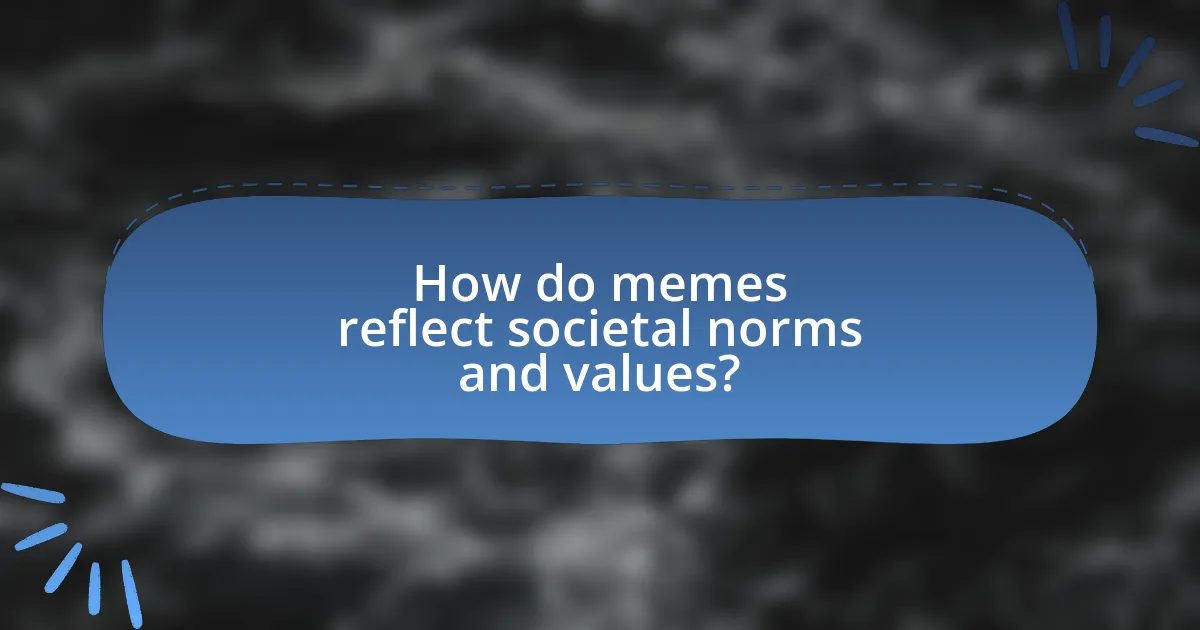
How do memes reflect societal norms and values?
Memes reflect societal norms and values by encapsulating shared beliefs, humor, and cultural references that resonate within a community. They serve as a mirror to contemporary issues, often highlighting social dynamics, political sentiments, and collective experiences. For instance, memes that address topics like mental health or social justice illustrate evolving attitudes towards these subjects, showcasing increased awareness and acceptance in society. Research indicates that memes can influence public opinion and reinforce cultural narratives, as seen in the viral spread of memes during significant events like elections or social movements, which often shape and reflect the prevailing societal discourse.
In what ways do memes serve as a commentary on current events?
Memes serve as a commentary on current events by distilling complex social and political issues into easily digestible and relatable formats. They often utilize humor, satire, and irony to critique or highlight societal reactions to events, making them accessible to a broad audience. For instance, during significant political events, memes can reflect public sentiment, such as frustration or disbelief, by exaggerating or simplifying the narratives surrounding those events. This phenomenon is supported by studies indicating that humor can facilitate discussions about sensitive topics, allowing individuals to engage with and process current events in a less confrontational manner.
How do memes shape public perception of social issues?
Memes shape public perception of social issues by simplifying complex topics into relatable and easily digestible content. This simplification allows for rapid dissemination of ideas, often leading to increased awareness and engagement among audiences. For instance, studies have shown that memes can influence political opinions and social movements, as seen during the Arab Spring, where memes played a crucial role in mobilizing youth and spreading information. Additionally, research indicates that memes can create a sense of community among users who share similar views, reinforcing existing beliefs and shaping collective attitudes towards social issues.
What examples illustrate memes influencing societal attitudes?
Memes have significantly influenced societal attitudes, as evidenced by the widespread adoption of the “Distracted Boyfriend” meme, which critiques infidelity and societal expectations in relationships. This meme became a cultural reference point, prompting discussions about loyalty and attraction, thereby shaping public perceptions of romantic relationships. Another example is the “Woman Yelling at a Cat” meme, which has been used to express frustration and disagreement, reflecting societal attitudes towards conflict and communication styles. These memes not only entertain but also serve as vehicles for social commentary, illustrating how humor can impact collective attitudes and behaviors.
How do memes create a sense of community among users?
Memes create a sense of community among users by facilitating shared experiences and cultural references that resonate with specific groups. This shared understanding fosters connection, as users engage with content that reflects their collective humor, values, and social norms. For instance, studies show that memes often encapsulate inside jokes or relatable scenarios that are unique to particular demographics, enhancing feelings of belonging. Additionally, the participatory nature of meme creation and sharing encourages interaction, allowing users to contribute their own variations and interpretations, which further solidifies community bonds.
What role does shared humor play in online communities?
Shared humor plays a crucial role in online communities by fostering social bonds and enhancing group identity. When members of an online community engage in humor, it creates a sense of belonging and strengthens interpersonal connections, as evidenced by studies showing that humor can increase group cohesion and trust among participants. For instance, research published in the journal “Computers in Human Behavior” indicates that shared humor can lead to increased engagement and satisfaction within online platforms, highlighting its importance in maintaining active and vibrant communities.
How do memes facilitate social interactions in digital spaces?
Memes facilitate social interactions in digital spaces by serving as a shared language that fosters connection and engagement among users. This shared language allows individuals to express emotions, humor, and cultural references succinctly, creating a sense of community. For instance, studies have shown that memes can enhance social bonding by providing relatable content that resonates with users’ experiences, thereby encouraging discussions and interactions. Additionally, the viral nature of memes promotes widespread sharing, which amplifies social engagement and reinforces group identity within online communities.
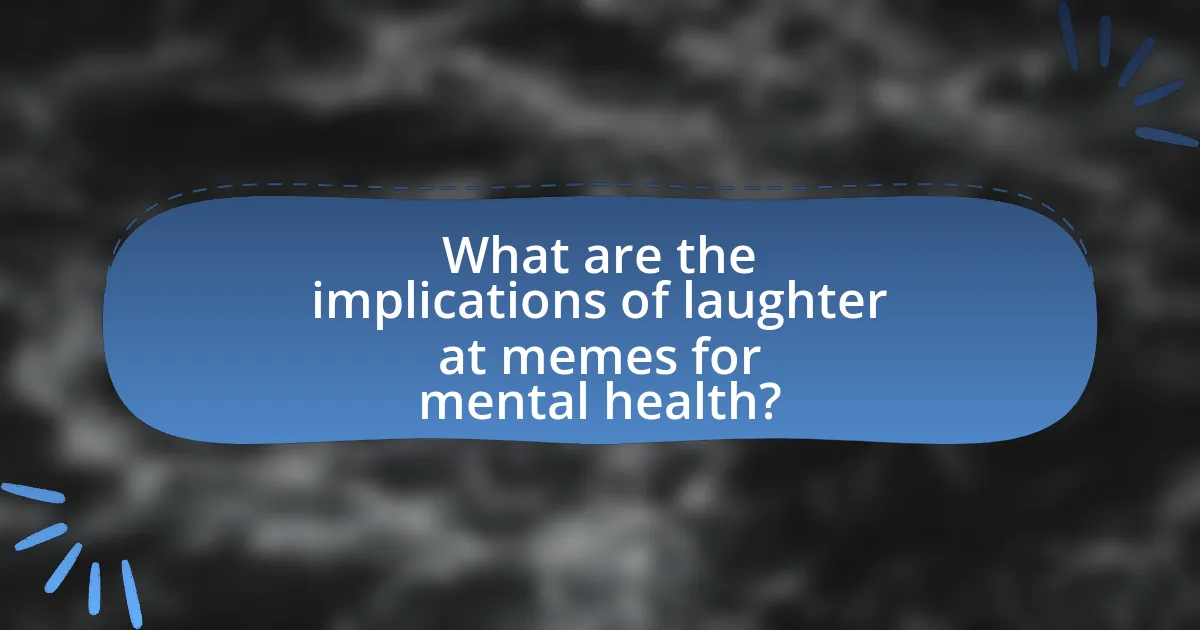
What are the implications of laughter at memes for mental health?
Laughter at memes has positive implications for mental health, as it can enhance mood and reduce stress. Engaging with humorous content, such as memes, triggers the release of endorphins, which are chemicals in the brain that promote feelings of happiness and well-being. Research indicates that laughter can lower cortisol levels, a hormone associated with stress, thereby contributing to improved mental health outcomes. Additionally, social interactions around memes can foster a sense of community and belonging, which are crucial for emotional support and resilience.
How can laughter from memes contribute to stress relief?
Laughter from memes contributes to stress relief by triggering the release of endorphins, which are chemicals in the brain that promote feelings of happiness and reduce pain. This physiological response occurs because humor activates the brain’s reward system, leading to a decrease in stress hormones such as cortisol. Research indicates that laughter can improve mood and foster social connections, both of which are essential for managing stress effectively. A study published in the journal “Psychological Science” found that humor can enhance resilience against stressors, demonstrating that engaging with humorous content, like memes, can serve as a coping mechanism during challenging times.
What psychological benefits are associated with humor in memes?
Humor in memes provides several psychological benefits, including stress relief, social connection, and enhanced cognitive flexibility. Stress relief occurs as laughter triggers the release of endorphins, promoting a sense of well-being. Social connection is fostered through shared humor, which strengthens interpersonal bonds and creates a sense of belonging among individuals who appreciate similar content. Enhanced cognitive flexibility arises as humor encourages creative thinking and problem-solving by allowing individuals to view situations from different perspectives. Research indicates that humor can improve mood and increase resilience, making it a valuable tool for coping with life’s challenges.
How does laughter at memes affect mood and well-being?
Laughter at memes positively affects mood and well-being by triggering the release of endorphins, which are chemicals in the brain that promote feelings of happiness and reduce stress. Studies indicate that humor, including that found in memes, can enhance social connections and foster a sense of belonging, which are crucial for mental health. For instance, research published in the journal “Psychological Science” by authors such as Robert Provine highlights that laughter can improve mood and increase resilience against stress. Additionally, engaging with humorous content like memes can serve as a coping mechanism, allowing individuals to navigate difficult emotions and situations more effectively.
What are some best practices for using memes in communication?
Best practices for using memes in communication include ensuring relevance to the audience, maintaining clarity in the message, and using humor appropriately. Relevance is crucial as memes that resonate with the audience’s interests or current events are more likely to be shared and understood. Clarity is important because a meme should convey its message quickly and effectively, avoiding confusion. Additionally, humor should be used carefully; it should enhance the message rather than detract from it, as inappropriate humor can alienate or offend the audience. Research indicates that humor in communication can increase engagement and retention of information, making it a powerful tool when used correctly.
How can memes be effectively used in educational settings?
Memes can be effectively used in educational settings by enhancing engagement and facilitating the retention of information. Research indicates that humor, such as that found in memes, can increase motivation and attention in learners, making complex subjects more relatable and easier to understand. For instance, a study published in the Journal of Educational Psychology found that incorporating humor into lessons improved students’ recall of information by up to 20%. Additionally, memes can serve as a tool for critical thinking, encouraging students to analyze and discuss the underlying messages or cultural references, thereby deepening their understanding of the subject matter.
What tips can enhance the humor and relatability of memes in social media?
To enhance the humor and relatability of memes in social media, creators should focus on using current cultural references and relatable everyday situations. Memes that incorporate trending topics or popular phrases resonate more with audiences, as they reflect shared experiences and collective humor. For example, memes that reference widely recognized events or viral challenges often achieve higher engagement rates. Additionally, employing simple and clear visuals paired with concise text can improve comprehension and impact, making the humor more accessible. Research indicates that humor is often derived from incongruity and surprise, so unexpected twists in familiar scenarios can amplify the comedic effect.
